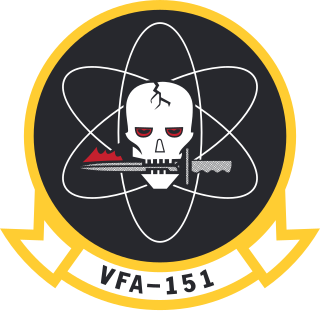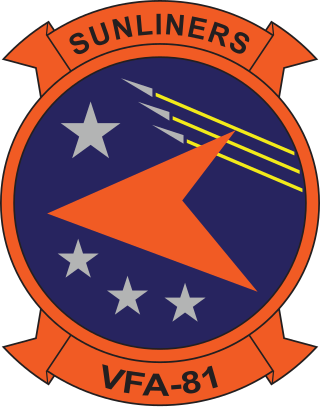
The McDonnell FH Phantom is a twinjet fighter aircraft designed and first flown during World War II for the United States Navy. The Phantom was the first purely jet-powered aircraft to land on an American aircraft carrier and the first jet deployed by the United States Marine Corps. Although only 62 FH-1s were built it helped prove the viability of carrier-based jet fighters. As McDonnell's first successful fighter, it led to the development of the follow-on F2H Banshee, which was one of the two most important naval jet fighters of the Korean War; combined, the two established McDonnell as an important supplier of navy aircraft.

The McDonnell F2H Banshee is a single-seat carrier-based jet fighter aircraft designed and produced by the American aircraft manufacturer McDonnell Aircraft. It was an early jet fighter operated by United States Navy and United States Marine Corps, as well as being the only jet-powered fighter to ever be deployed by the Royal Canadian Navy. The aircraft's name is derived from the banshee of Irish mythology.

VFA-31 or Strike Fighter Squadron 31 is known as the Tomcatters, callsign "Felix", a United States Navy strike fighter squadron stationed at Naval Air Station Oceana flying the F/A-18E Super Hornet. The Tomcatters are the second oldest Navy Fighter Attack squadron operating today.

Strike Fighter Squadron 102 (VFA-102) is a United States Navy Strike Fighter squadron based at Marine Corps Air Station Iwakuni. Their call sign is Diamond, with the tail code NF, and they fly the F/A-18F Super Hornet.

Strike Fighter Squadron 41 (VFA-41) also known as the "Black Aces", is a United States Navy strike fighter squadron based at Naval Air Station Lemoore, California, flying the F/A-18F Super Hornet. They are attached to Carrier Air Wing 9 (CVW-9). Their radio callsign is "Fast Eagle" and their tailcode is NG.

Strike Fighter Squadron One Five One (VFA-151) nicknamed the Vigilantes are a United States Navy F/A-18E Super Hornet fighter squadron stationed at Naval Air Station Lemoore, California. The squadron is a part of Carrier Air Wing 9 (CVW-9). As part of CVW-9, the squadron's tail code is NG and its radio callsign is "Ugly".

Strike Fighter Squadron 11 (VFA-11) is a United States Navy strike fighter squadron stationed at Naval Air Station Oceana, Virginia, United States. The squadron was established in 1950 and is nicknamed "Red Rippers". VFA-11 is equipped with the Boeing F/A-18F Super Hornet and currently assigned to Carrier Air Wing One.

Fighter Squadron 33 (VF-33) was an aviation unit of the United States Navy. Originally established on 11 October 1948 it was disestablished on 1 October 1993. It was the second U.S. Navy squadron to be designated VF-33.
Fighter Squadron 11 or VF-11 was an aviation unit of the United States Navy. It was originally established as VF-5 on 1 February 1927, redesignated as VF-5S on 1 July 1927, redesignated as VF-5B in January 1928, redesignated VB-1B on 1 July 1928, redesignated VF-5B on 1 July 1930, redesignated VF-5S in July 1932, redesignated VF-5B in April 1933, redesignated VF-4 on 1 July 1937, redesignated VF-41 on 15 March 1941, redesignated VF-4 on 4 August 1943, redesignated VF-1A on 15 November 1946, redesignated VF-11 on 2 August 1948 and disestablished on 15 February 1959. It was the second US Navy squadron to be designated VF-11.

Fighter Squadron 53, or VF-53Iron Angels was an aviation unit of the United States Navy in service from 20 July 1950 to 29 January 1971. Originally established as reserve squadron VF-721 on 20 July 1950, it was redesignated as VF-141 on 4 February 1953 and then redesignated as VF-53 on 15 October 1963. The squadron was disestablished on 29 January 1971. It was the fourth US Navy squadron to be designated as VF-53.

Strike Fighter Squadron 81 (VFA-81), also known as the "Sunliners", is a United States Navy F/A-18E Super Hornet strike fighter squadron stationed at Naval Air Station Oceana. They are currently assigned to Carrier Air Wing 1. Their mission is to conduct prompt and sustained combat operations from the sea. The squadron was originally designated VA-66 on 1 July 1955, was redesignated VF-81 the same day, redesignated VA-81 on 1 July 1959, and finally redesignated VFA-81 on 4 February 1988.

VA-106 was an Attack Squadron of the U.S. Navy. Originally established as Bomber-Fighter Squadron Seventeen (VBF-17) on 2 January 1945, it was redesignated Fighter Squadron Six B (VF-6B) on 15 November 1946, redesignated VF-62 on 28 July 1948, redesignated Attack Squadron 106 (VA-106) on 1 July 1955, it was disestablished on 7 November 1969. It was the second US Navy squadron to be designated VA-106.

VA-172 was an Attack Squadron of the U.S. Navy. It was established as Bomber Fighter Squadron VBF-82 on 20 August 1945, redesignated as Fighter Squadron VF-18A on 15 November 1946, as VF-172 on 11 August 1948, and as VA-172 on 1 November 1955. The squadron was disestablished on 15 January 1971. Its nickname was the Checkmates from 1946-1950, and the Blue Bolts thereafter.

VA-34, nicknamed the Blue Blasters, was an Attack Squadron of the U.S. Navy. The squadron was established as Fighter Squadron VF-20 on 15 October 1943, redesignated as VF-9A on 15 November 1946, as VF-91 on 12 August 1948, and as VF-34 on 15 February 1950. It was finally redesignated VA-34 on 1 July 1955. The squadron was disestablished on 1 June 1969. It was the second squadron to bear the VA-34 designation, the first one having been renamed VA-35 in 1950.

Attack Squadron TWELVE, also known as the "Flying Ubangis" or "Clinchers", was an attack squadron of the United States Navy active during the Cold War. From their home port at Naval Air Station Cecil Field in Florida, the squadron made more than thirty major overseas deployments aboard aircraft carriers, primarily flying A-4 Skyhawk and later the A-7E Corsair II, including two combat tours in the Vietnam War.

Fighter Squadron 96, or VF-96Fighting Falcons was an aviation unit of the United States Navy in service from 1962 to 1975. When assigned to Carrier Air Wing Nine (CVW-9) their tailcode was NG, and their radio callsign was Showtime. Originally established as United States Naval Reserve squadron VF-791Fighting Falcons on 20 July 1950 it was redesignated VF-142 after becoming a regular squadron on 4 February 1953. It was re-designated VF-96 on 1 June 1962 and disestablished on 1 December 1975.

Fighter Squadron 52 or VF-52 was an aviation unit of the United States Navy. Originally established as Bombing Fighting Squadron 5 (VBF-5) on 8 May 1945, it was redesignated Fighting Squadron 6A (VF-6A) on 15 November 1946, redesignated as Fighter Squadron 52 (VF-52) on 16 August 1948 it was disestablished on 23 February 1959. It was the third US Navy squadron to be designated as VF-52.
Fighter Squadron 71 or VF-71 was an aviation unit of the United States Navy. Originally established as VGS-18 on 15 October 1942, it was redesignated VC-18 on 1 March 1943, redesignated as VF-36 on 15 August 1943, redesignated as VF-18 on 5 March 1944, redesignated as VF-7A on 15 November 1946, redesignated as VF-71 on 28 July 1948 and disestablished on 31 March 1959.

Fighter Squadron 22 or VF-22 was an aviation unit of the United States Navy. Originally established as Bombing Fighting Squadron 74A (VBF-74A) on 1 May 1945, it was redesignated VBF-74 on 1 August 1945, redesignated as VF-2B on 15 November 1946, redesignated as VF-22 on 1 September 1948, it was disestablished on 6 June 1958.

Fighter Squadron 82 or VF-82 was an aviation unit of the United States Navy. Originally established as Reserve Squadron VF-742 it was called to active duty during World War II and later recalled on 2 February 1951, redesignated VF-82 on 4 February 1953, it was disestablished on 15 April 1959. It was the third US Navy squadron to be designated VF-82.





















